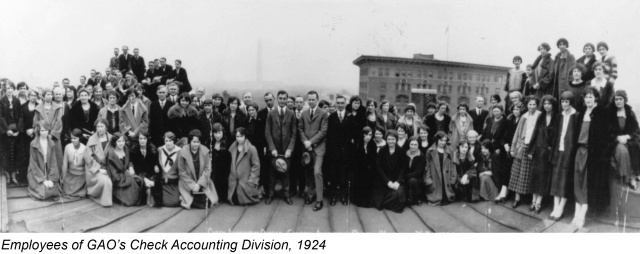Women’s History Month: The Story of Women at GAO
For Women’s History Month, we’ve blogged about our work on women’s issues.
Today, we’re sharing a glimpse of the story (past and present) of women at GAO.
In 1921, GAO had 1,708 employees. Like the federal government in general, GAO’s workforce grew during World War II to more than 14,000 at its peak in 1946. Women accounted for a large part of this federal hiring, and over 60% of GAO employees at war’s end were women, mostly in clerical positions, with some notable exceptions.
The GAO workforce shrank after the war, and the proportion of women dropped, too. The nature of the work became more professional, requiring degrees and training in accounting and auditing. Comptroller General Lindsay Warren’s executive officer is on record in early 1945 as saying, “Practically any position in the office is available for women, if they can make the grade; that is, they are not stopped because they happen to be women.” However, in that postwar period, women were generally less likely to pursue the training required, if they were even in the workforce at all.
GAO leadership at the time also expressed reluctance to assign women to “comprehensive audit work” because of complications that might arise with travel, and because of leadership’s beliefs regarding how other government agencies might perceive women auditors.

In her own words
As part of an oral history project, three women (two attorneys and one administrative assistant, shown right) spoke about their thoughts and experiences as GAO employees in the office of General Counsel and the Transportation Division. The transcript of the interview was published in 1990 and chronicles the realities of being a working woman—or rarer still, a woman attorney—from the 1940s through the 1980s.
One of the women interviewed, Ms. Rubar, described working at GAO during the war years:
And, of course, the men weren’t used to working with women except when the women were in a subservient capacity, and they found it a little bit difficult, I think.
Later, Ms. Rubar earned her law degree. However, she initially didn’t apply to work as an attorney for the agency. As she described the situation,
…[the Associate General Counsel] knew when I passed the bar, and he said that was wonderful, but he said to tell me not to think I was ever going to come to work in the General Counsel’s office because that office will never have a woman… There had been a woman, apparently a long time before, who had been extremely difficult, and, of course, men could be difficult and get away with it in those times, but women could not.
However, she ultimately got the job. She told the historian, Dr. Roger Trask, that Elmer Staats, the Comptroller General at the time, was “wonderful.”
I think he did a great deal to help women and minorities and to try to eradicate any kind of prejudice that existed…I just felt very proud of working for him.
One of the best places to work
And he and other subsequent GAO leaders continued to push for change. In 1987, 39% of employees at GAO were women—and less than 10% of our executives. Fewer than 1 in 5 women at GAO that year had a graduate or advanced degree.
Today, women comprise well over half of the staff at the agency, and fill 40% of our executive positions. Nearly 60% have a graduate or advanced degree and two different women have served as General Counsel, the top attorney at the agency.
We even received a nod from The Washington Post in October for some of these numbers, and for consistently being rated one of the Best Places to Work in the federal government.
You can learn more about GAO’s history—our building, our name, and past Comptrollers General, on the WatchBlog and also by checking out the history section of our website.
- Comments on the WatchBlog? Contact blog@gao.gov.
GAO Contacts
Related Products

GAO's mission is to provide Congress with fact-based, nonpartisan information that can help improve federal government performance and ensure accountability for the benefit of the American people. GAO launched its WatchBlog in January, 2014, as part of its continuing effort to reach its audiences—Congress and the American people—where they are currently looking for information.
The blog format allows GAO to provide a little more context about its work than it can offer on its other social media platforms. Posts will tie GAO work to current events and the news; show how GAO’s work is affecting agencies or legislation; highlight reports, testimonies, and issue areas where GAO does work; and provide information about GAO itself, among other things.
Please send any feedback on GAO's WatchBlog to blog@gao.gov.





